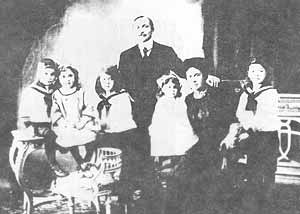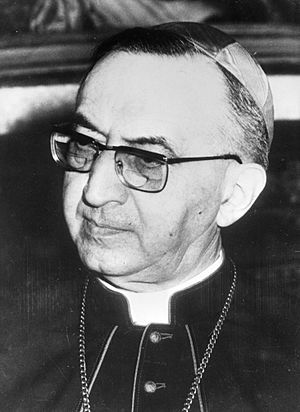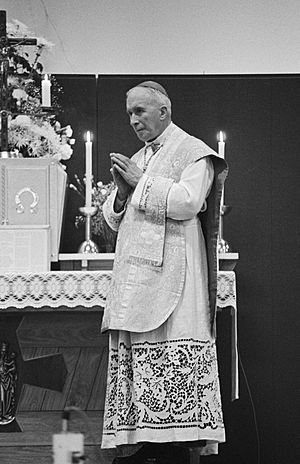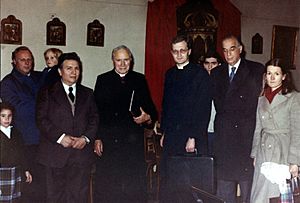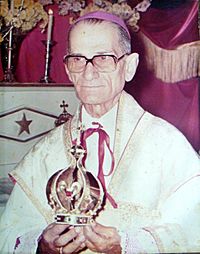Marcel Lefebvre facts for kids
Quick facts for kids His Grace Marcel Lefebvre C.S.S.p., S.S.P.X. |
|
|---|---|
| Archbishop-Bishop Emeritus of Tulle | |
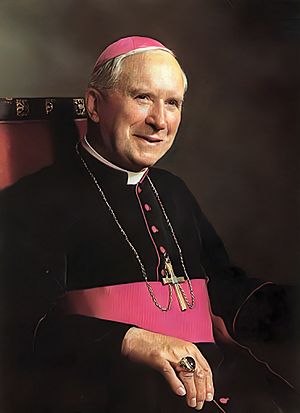
Archbishop Lefebvre, circa 1962.
|
|
| See | Tulle |
| Appointed | 23 January 1962 |
| Reign ended | 7 August 1962 |
| Predecessor | Aimable Chassaigne |
| Successor | Henri Clément Victor Donze |
| Other posts | Founder and Superior General of the Society of Saint Pius X (1970–1982) |
| Orders | |
| Ordination | 21 September 1929 |
| Consecration | 18 September 1947 by Achille Liénart |
| Personal details | |
| Birth name | Marcel-François Marie Joseph Lefebvre |
| Born | 29 November 1905 Tourcoing, France |
| Died | 25 March 1991 (aged 85) Martigny, Switzerland |
| Buried | International Seminary of Saint Pius X, Écône, Switzerland |
| Nationality | French |
| Denomination | Catholic |
| Parents | René Lefebvre (father) Gabrielle Watine (mother) |
| Previous post |
|
| Alma mater | (Pontifical) French Seminary, Rome |
| Motto | Credidimus caritati (We believed in charity) |
| Coat of arms |  |
Marcel François Marie Joseph Lefebvre (born November 29, 1905 – died March 25, 1991) was a French Catholic archbishop. He had a big impact on a part of Catholicism called traditional Catholicism. In 1970, he started a group called the Society of Saint Pius X (SSPX). This group was created to train future priests. It was located in a village in Switzerland called Écône. In 1988, he was excommunicated from the Catholic Church. This happened because he consecrated four bishops without permission from Pope John Paul II.
Marcel Lefebvre became a priest in 1929. He joined the Holy Ghost Fathers to work as a missionary. In 1932, he was sent to teach at a seminary in Gabon, Africa. In 1947, he became a Vicar Apostolic in Dakar, Senegal. The next year, he became the Apostolic Delegate for West Africa. When he returned to Europe, he was chosen to lead the Holy Ghost Fathers. He also helped prepare documents for the Second Vatican Council (1962–1965). This important meeting was announced by Pope John XXIII.
Lefebvre was a main leader of the conservative group during the Council. He later disagreed with some changes in the Church that came from the Council. He refused to make the changes that the Holy Ghost Fathers wanted. So, he resigned from his leadership role in 1968. In 1970, he started the Society of Saint Pius X (SSPX). It began as a small group of students in Écône, Switzerland, with the local bishop's approval.
In 1975, tensions grew between Lefebvre and the Holy See (the Pope's main office). He was told to close his society, but he did not. He kept the SSPX active. In 1988, he consecrated four bishops to continue his work with the SSPX. He did this even though Pope John Paul II had clearly forbidden it. The Holy See immediately said that he and the other bishops involved were automatically excommunicated. This is a serious penalty in Catholic canon law. Lefebvre did not accept this decision.
Contents
Early Life and Family
Marcel Lefebvre was born in Tourcoing, France. He was the third of eight children. His father, René Lefebvre, owned a textile factory. His mother, Gabrielle Watine, passed away in 1938.
His parents were very religious Catholics. They took their children to Mass every day. His father, René, strongly supported the idea of a monarchy. He believed that a king would bring back France's past greatness and Christian values.
During World War I, when Tourcoing was under German control, his father helped the British Intelligence. René died in 1944 at 65 years old.
Becoming a Priest
In 1923, Marcel Lefebvre started studying to become a priest. His father wanted him to study at the French Seminary in Rome. His father thought other seminaries might have too liberal ideas. Lefebvre later said that the seminary's leader, Father Henri Le Floch, helped him develop his conservative views. He paused his studies in 1926 and 1927 for military service.
On May 25, 1929, he became a deacon in Rome. On September 21, 1929, he was ordained a priest. This happened in the Diocese of Lille. After becoming a priest, he continued his studies in Rome. He earned a doctorate in theology in July 1930.
Lefebvre wanted to be a missionary with the Holy Ghost Fathers. But first, his bishop asked him to work in a parish in Lomme, France. In July 1931, he was allowed to join the Holy Ghost Fathers. He took his first vows in September 1932.
His first job as a Holy Ghost Father was teaching. He taught at St. John's Seminary in Libreville, Gabon. In 1934, he became the head of that seminary. He took his final vows in September 1935. He also led several missions for the Holy Ghost Fathers in Gabon. In October 1945, Lefebvre returned to France. He became the head of the Holy Ghost Fathers seminary in Mortain.
Bishop in Africa
On June 12, 1947, Pope Pius XII made him the Vicar Apostolic of Dakar in Senegal. He was also named a titular bishop of Anthedon. On September 18, 1947, he became a bishop in his family's church in Tourcoing.
As Vicar Apostolic, Lefebvre was in charge of a large area. It had three and a half million people. Only 50,000 of them were Catholic.
On September 22, 1948, Lefebvre got more responsibilities. He became the Apostolic Delegate to French Africa. His title changed to titular archbishop of Arcadiopolis in Europa. He represented the Pope to Church leaders in 46 dioceses. These were in French-controlled Africa and nearby islands.
In the late 1940s, Lefebvre started a program in Paris. It helped Catholic students from African colonies. He and other missionaries believed this would keep young Africans from radical ideas. Pope Pius XII later supported this idea.
Lefebvre's main job was to build up the Church in French Africa. Pope Pius XII wanted to quickly create dioceses instead of vicariates. Lefebvre chose new bishops and increased the number of priests and churches. On September 14, 1955, Pope Pius reorganized the Church in French Africa. The Apostolic Vicariate of Dakar became an archdiocese. Lefebvre became its first archbishop.
Changes and the Second Vatican Council
After Pope Pius XII died, Lefebvre's career changed. He moved from missionary work to Rome. Pope John XXIII replaced him as Apostolic Delegate in Dakar in 1959. The next year, Pope John appointed Lefebvre to a group helping prepare for the Second Vatican Council.
Senegal became independent in 1960. Its first president, Léopold Sédar Senghor, wanted a type of socialism. Lefebvre, still Archbishop of Dakar, disagreed with Senghor's ideas. He criticized them in a letter and in person. He used Pope Pius XI's disapproval of socialism from 1931. Because of this disagreement, Lefebvre's position became difficult. The Holy See started replacing European bishops with Africans. Lefebvre tried to delay his own removal. He said Africans were "not yet ripe" for leadership. Pope John said he would take responsibility and ensure Lefebvre was cared for.
On January 23, 1962, Lefebvre was moved to the Diocese of Tulle in France. This was one of the smallest dioceses. He kept his personal title of archbishop. On April 4, 1962, he was named a consultant for a Vatican group.
On July 26, 1962, the Holy Ghost Fathers elected Lefebvre as their leader. He won a large majority of votes. He resigned as bishop of Tulle. Pope John accepted his resignation on August 7. He then named Lefebvre titular archbishop of Synnada in Phrygia.
Role in the Council
As part of the planning group, Lefebvre helped write documents for the Council. But when the Council started in October 1962, the bishops rejected all the early drafts.
Lefebvre and other bishops were worried about the Council's direction. They formed a group called the Coetus Internationalis Patrum (CIP). This group wanted to make sure their conservative views were heard in every discussion.
The CIP was especially concerned about religious liberty. During the Council's third meeting (1964), a Vatican official announced that Lefebvre and two other bishops would rewrite a document on this topic. But it turned out this was not approved by the Pope. The main responsibility for the document went to another group.
The CIP managed to delay the vote on the document. Finally, on December 7, 1965, the Council approved the document Dignitatis humanae. Lefebvre was one of 70 bishops who voted against it. But he still signed the document after the Pope.
Changes within the Holy Ghost Fathers
During the Council, about 40 bishops from the Holy Ghost Fathers met with Lefebvre. They disagreed with his views and his role at the Council. He listened but did not discuss. He ended the meeting by saying, "We all have a conscience: everyone must follow his own." This left them unhappy. One bishop said Lefebvre seemed "incapable of reviewing his ways of thinking."
The Holy Ghost Fathers held a special meeting to respond to the Council's changes. The leaders resigned, as was traditional. The members wanted more elected representatives. Lefebvre's opponents were well organized. When he tried to lead the meeting, they insisted on electing their own leaders. On September 11, 1968, the meeting voted 63 to 40 against Lefebvre leading. He stopped attending. The group then elected new leaders. They debated how to balance their religious life with their missionary work. Lefebvre returned on September 28. He spoke strongly against any changes. He said changes would lead to "anarchy, disorder, and individual initiative." His words did not gain him support. On October 26, the group elected Fr. Joseph Lécuyer as the new leader.
Beliefs and Views
Lefebvre held strong beliefs that were common among some French Catholics. These views came from a long history of disagreements in France. These disagreements were between secular (non-religious) groups and Catholic groups.
Religious Beliefs
Lefebvre believed in:
- Rejecting what he called 'false' ecumenism. He favored the idea that Catholicism was the only true religion.
- Supporting practical religious tolerance instead of the principle of religious liberty.
- Rejecting shared leadership (collegiality) in the Church. He preferred strong papal supremacy (the Pope's ultimate authority).
- Opposing the new Mass of Paul VI. He preferred the older Tridentine Mass.
Political Views
Lefebvre's political views included:
- Condemning the 1789 French Revolution. He called its ideas "Masonic and anti-Catholic."
- Supporting the "Catholic order" of the French Vichy government (1940–1944). This was an authoritarian government.
- Supporting the National Front, a political party in France.
- Opposing Muslim immigration into Europe. In 1990, he was fined in a French court for comments he made about this.
Society of Saint Pius X
Starting the Society
After leaving his role as leader of the Holy Ghost Fathers, Lefebvre met some traditional Catholic students. They had been refused a special rite to become clerics. They asked him for a conservative seminary to finish their studies. Lefebvre first sent them to a university in Switzerland. But then he was asked to teach them himself. In 1969, he got permission from the local bishop to start a seminary in Fribourg. It opened with nine students. In 1971, it moved to Écône, Switzerland.
Lefebvre suggested creating a group of priests without special vows. In November 1970, Bishop François Charrière of Fribourg officially started the International Priestly Society of Saint Pius X (SSPX). It was a "pious union" for a trial period of six years.
Early Challenges
In November 1972, the bishops of France were suspicious of the Écône seminary. They called it an "Outlaw Seminary." They said they would not accept any of its students as priests. Cardinal Secretary of State Jean-Marie Villot told Pope Paul VI that Lefebvre made his students sign a paper against the Pope. Lefebvre strongly denied this.
Vatican Investigations
In November 1974, two priests inspected the SSPX seminary. They were sent by a group of cardinals. It was said they wrote a good report. On November 21, 1974, Lefebvre wrote a "Declaration." In it, he criticized what he saw as modernist and liberal changes in the Church. He later said he was "excessively indignant" when he wrote it.
The cardinals' group replied that his declaration was "unacceptable."
In January 1975, Bishop Pierre Mamie decided the SSPX's status as a "pious union" should end. He asked a Vatican official to cancel its status.
On February 13, Lefebvre was called to Rome. He described the meeting as a "close cross examination." It was about his "Declaration." There was a second meeting on March 3. In May, the cardinals' group approved Bishop Mamie's plan. Lefebvre argued that only the Pope could close a religious group. He said it had to be by a direct order.
The Vatican official agreed with Mamie. Mamie then closed the SSPX on May 6, 1975. Pope Paul VI supported this decision. Lefebvre continued his work. He said that the SSPX had not been "legally suppressed." He also said the Vatican's own report was positive. He appealed the decision twice to the Church's highest court. Lefebvre later wrote that Cardinal Villot stopped these appeals.
In 1976, Bishop Mamie warned Lefebvre. He said that celebrating Mass after being forbidden would make his relationship with Rome worse.
Disagreements with the Vatican
On May 24, 1976, Pope Paul VI publicly criticized Lefebvre. He asked Lefebvre and his followers to change their minds.
On June 29, 1976, Lefebvre went ahead with planned priestly ordinations. He did this without the local bishop's approval. He also ignored letters from Rome forbidding them. Because of this, Lefebvre was forbidden from ordaining any more priests. A week later, a Vatican official told him he needed to apologize to the Pope. Lefebvre replied with a letter. He claimed the Church's modernization was a "compromise with modern ideas." He said it came from a secret agreement between Church leaders and Freemasons. Lefebvre was then told he could no longer legally perform any sacraments. Lefebvre noted he had been forbidden from celebrating the new Mass. Pope Paul took this seriously. He said Lefebvre thought he could avoid punishment by using older forms of sacraments. Despite being suspended, Lefebvre continued to celebrate Mass and perform other sacraments. This included ordaining students from his seminary.
Pope Paul met with Lefebvre on September 11, 1976. A month later, he wrote to Lefebvre, warning him and repeating his appeal. Pope John Paul II met Lefebvre after becoming Pope in 1978. Lefebvre asked Pope John Paul II to let him work with the SSPX without supervision. Pope John Paul II refused this request.
Écône Consecrations
In 1987, Lefebvre was 81 years old and his health was failing. He announced he planned to consecrate a bishop. This bishop would continue his work after his death. However, under Catholic canon law, consecrating a bishop without the Pope's permission leads to excommunication. This means being cut off from the Church.
During 1987, Lefebvre tried to reach an agreement with Cardinal Joseph Ratzinger. Ratzinger was in charge of a Vatican group (he later became Pope Benedict XVI). But on September 4, 1987, Lefebvre said the Vatican was in a state of apostasy (abandoning the faith). He declared he would no longer work with Ratzinger.
On May 5, 1988, Lefebvre signed an agreement with Ratzinger. This agreement was meant to make the SSPX's situation official with the Church. Ratzinger agreed that one bishop would be consecrated for the Society. This bishop would be approved by the Pope.
Breaking the Agreement
Soon after signing the agreement, Lefebvre said he received a note from Ratzinger. It asked him "to beg pardon for [his] errors." Lefebvre understood this to mean he would have to accept the teachings of the Second Vatican Council. He also thought it meant accepting the "spirit of Assisi" (a meeting of different religions). Lefebvre mentioned a prophecy that "Rome will lose the Faith." He said he had to consecrate a successor, even without papal approval. The agreement did not set a date for the bishop's consecration. If Lefebvre died before it happened, the Society would not be able to ordain priests. This would force them to submit to the Holy See.
Lefebvre called his plan "Operation Survival."
Pope John Paul II asked him not to go ahead. He warned that it would be a "schismatic act." This meant it would cause a split from the Church. He also warned of serious "theological and canonical consequences."
On June 30, 1988, Lefebvre consecrated four SSPX priests as bishops. Bishop Emeritus Antônio de Castro Mayer from Brazil helped him. The four new bishops were Bernard Tissier de Mallerais, Richard Williamson, Alfonso de Galarreta, and Bernard Fellay.
The next day, July 1, the Vatican said this was a schismatic act. It declared that all six people involved were automatically excommunicated.
Aftermath
Lefebvre disagreed with Pope John Paul II. He said he and the others had not "separated themselves from Rome." He said they were not schismatic. He claimed they were in a "case of necessity." He said they could not make "Rome" understand that the changes since the Second Vatican Council were "not Catholic." In a letter to the priests he was about to consecrate, Lefebvre wrote: "I do not think one can say that Rome has not lost the Faith."
On July 18, twelve priests and some students left the SSPX. They left because of the Écône consecrations. One of them, Josef Bisig, became the first leader of a new group. This group, the Priestly Fraternity of St. Peter, reached an agreement with the Holy See.
Death
Marcel Lefebvre died from cancer on March 25, 1991. He was 85 years old. He passed away in Martigny, Switzerland. Eight days later, he was buried in the crypt at the SSPX seminary in Écône. The Pope's representative to Switzerland and the local bishop came to pray at his body.
Legacy of the 1988 Consecrations
Excommunications Lifted
On March 10, 2009, Pope Benedict XVI lifted the excommunications of the four surviving bishops. This was done at their request.
Bishops Consecrated by Lefebvre
The line of bishops started by the 1988 consecrations includes 9 bishops as of 2019. Eight of them are still alive:
- Bp Alfonso Ruiz de Galarreta
- Bp Licinio Rangel (consecrated by Bp Bernard Tissier de Mallerais – with Bp Alfonso Ruiz de Galarreta also helping)
- Bp Bernard Fellay
- Bp Bernard Tissier de Mallerais
- Bp Licinio Rangel (+)
- Bp Fernando Arêas Rifan (consecrated by Cdl Dario Castrillon Hoyos – with Bp Licinio Rangel also helping)
- Bp Licinio Rangel (+)
- Bp Richard Nelson Williamson
- Bp Licinio Rangel (consecrated by Bp Bernard Tissier de Mallerais – with Bp Richard Nelson Williamson also helping)
- Bp Jean-Michel Faure
- Bp Dom Tomás de Aquino Ferreira da Costa (consecrated by Bp Richard Nelson Williamson – with Bp Jean-Michel Faure also helping)
- Bp Gerardo Zendejas (consecrated by Bp Richard Nelson Williamson – with Bp Jean-Michel Faure & Bp Dom Tomás de Aquino Ferreira da Costa also helping)
Awards and Honors
Marcel Lefebvre received awards from several governments, including:
- France: Legion of Honor
- Gabon: Equatorial Star of Gabon
- Senegal: Grand National Order of Senegal
Writings
- Lefebvre, Marcel (1998). A Bishop Speaks: Writings & Addresses, 1963–1974. Kansas City, Mo.: Angelus Press. ISBN 0-935952-16-0.
- Lefebvre, Marcel (1998). I Accuse the Council! (2nd ed.). Kansas City, Mo.: Angelus Press. ISBN 978-0-935952-68-1.
- Lefebvre, Marcel (1987). Open Letter to Confused Catholics. Kansas City, Mo.: Angelus Press. ISBN 978-0-935952-13-1. Translated from the original book: Lefèbvre, Marcel (1985) (in fr). Lettre Ouverte aux Catholiques Perplexes. Paris: A. Michel. ISBN 978-2-226-02325-4.
- Lefebvre, Marcel (1997). Against the Heresies. Kansas City, Mo.: Angelus Press. ISBN 978-0-935952-28-5.
- Lefebvre, Marcel (1988). They Have Uncrowned Him: From Liberalism to Apostasy, the Conciliar Tragedy. Dickinson, Tex: Angelus Press. ISBN 0-935952-05-5.
- Lefebvre, Marcel (2000). The Mystery of Jesus: the Meditations of Archbishop Marcel Lefebvre. Kansas City, Mo.: Angelus Press. ISBN 978-1-892331-02-1.
- Lefebvre, Marcel (2001). Religious Liberty Questioned – The Dubia: My Doubts about the Vatican II Declaration of Religious Liberty. Kansas City, Mo.: Angelus Press. ISBN 978-1-892331-12-0.
- Lefebvre, Marcel (2007). The Mass of All Time: the Hidden Treasure. Kansas City, Mo.: Angelus Press. ISBN 978-1-892331-46-5.
See Also
 In Spanish: Marcel Lefebvre para niños
In Spanish: Marcel Lefebvre para niños
- Marcel Lefebvre – Archbishop in Stormy Times, a 2012 documentary film.


